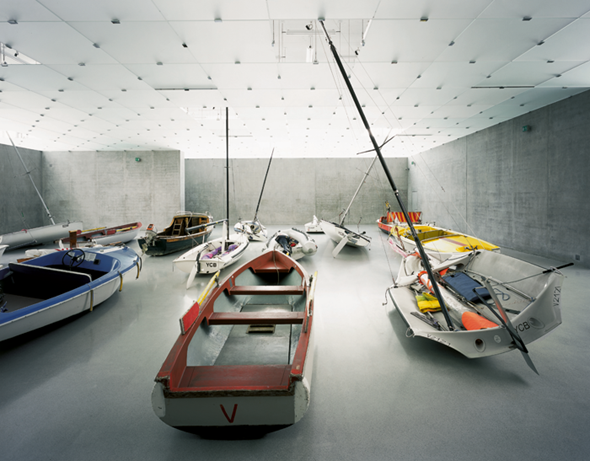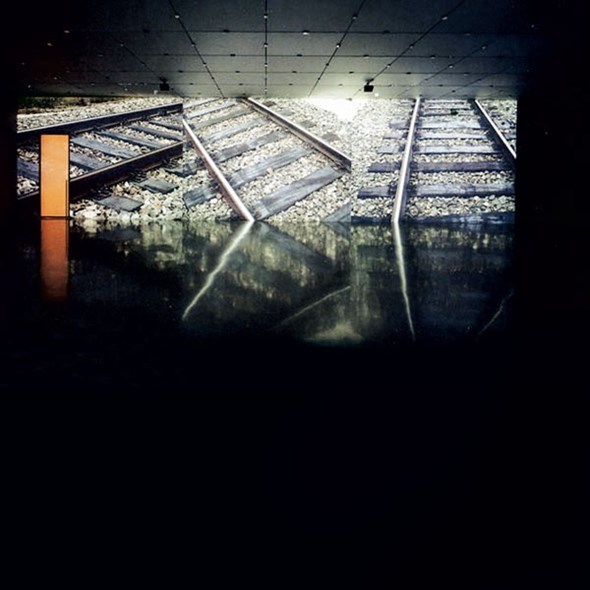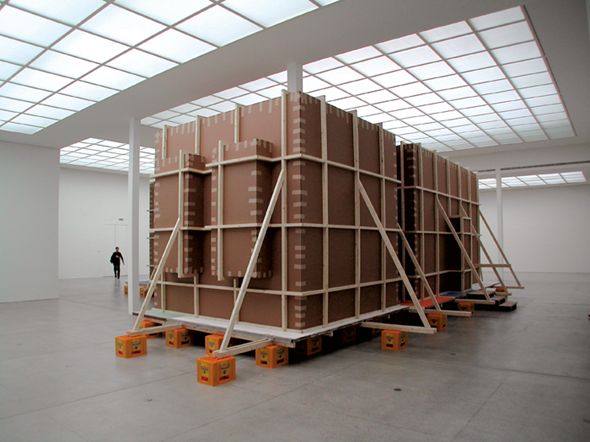
Photo: Bruno Klomfar
Hans Schabus leads expeditions. To set an example for us, he travels through imaginary worlds in his self-made vehicles. And yet his journeys are not hectic, but rather the opposite. In 2003 he dug his way through to the Vienna Secession; last year he extended the Arlberg Tunnel as far as the Kunsthaus in Bregenz. This year HANS SCHABUS is representing Austria at the Biennale di Venezia and is turning the pavilion into a Trojan Horse. A portrait by VITUS H. WEH
We like to have some experiences for ourselves; there are others we are happy to delegate if we can. For example, flying from the earth to the moon, spending time 20,000 miles under the sea, making a journey to the centre of the earth or travelling around the world as fast as possible. In the 19th century people read about such things in the novels of Jules Verne and let them be carried out by such characters as Captain Nemo, Robur the Conqueror, Phileas Fogg or the President of the Gun Club, Impey Barbicane. Jules Verne, whose 100th birthday has just been up for celebration, mapped all the heights and depths of the then known world with his passion for writing. Like a journey around the world in 65 novels.
The fact that there is a mental world, alongside the physical world whose dimensions he measured, was not a theme that interested Jules Verne. It is of all the more interest to Hans Schabus. He is a post- Freudian leader of expeditions, similar to Jules Verne in his weaving of curious fables and in the density of his atmosphere, but Schabus’ space voyages are not into exotic external worlds but into the nearest interior worlds. Instead of a linear novel there are looped films for which a variety of vehicles – boats, cars, trains – are built in complex ways, objects to accompany a life on the move. Schabus offers no journey into the distance but rather into apparently motionless spaces – into memory complexes smothered with sediment – but what matters for him, too, are voyages extraordinaires.
The place where his extraordinary voyages start and end has mostly been his studio in Vienna. An artist’s studio is often seen as a place of brilliant inspiration, the elated genius, the flight of thought. For Hans Schabus it becomes a cellar where flights of fantasy are fermented, thoughts ground down by their own rotation, uncanny selfobservations of the second and third degree. For his video Passagier [Passenger] (2000) he installed a model railway track under the ceiling of his studio, running through all the various zones of his workshop – from the machine-room through the kitchen to the toilet. For the video, a camera was mounted on the railway. Looking back to the railway lines, the eye of the camera goes on its rounds through walls and junk rooms and past windows and shelves, while the artist’s actions, happening at the same time, can only be observed marginally, from a birdseye perspective and by means of sound.

Similarly circling around the theme of the hermetic self is Hole of Babel, a work from 2003. In his ground-floor studio, Schabus took up a spade for three or four hours every day and dug into the ground, deeper and deeper. That went on, accompanied by film cameras for two or three months. Soon the dislodged earth filled the work-room. At a depth of five metres he had to stop. The hole was sweating and bleeding like a chimney flue for sheer humidity. Digging on through to the exhibition halls of the Vienna Secession, moving both himself and the body of his studio, was left to film montage. The exhibition in the Secession at the time was called Astronaut (be right back): the entrance was walled up and it was possible to approach the important main hall only from the basement, up provisionally carpentered steps and holes in the walls. There one found a White Cube, like a stage set, whose dazzling white emptiness represented both the now classical way of presenting art and the white-out effect, the loss of physical and mental orientation, experienced by polar explorers or seamen crossing the Atlantic under extreme conditions. At the same time, when visitors suddenly emerged into this setting they were reminded of the last space in Stanley Kubrick’s 2001: A Space Odyssey. That is also a legendary nightmare of the silent need to encounter and observe oneself.
The cosmos of cinema is everywhere in the work of Hans Schabus: his research work and preparations are similarly exhaustive, the project sketches and models similarly painstaking. By the time a project is ready, a year may easily have passed. For his Video Western, which caused a furore at Manifesta 4 in Frankfurt in 2002 with its narrative directness and melancholy undertow effect, he first built, for example, a yacht of the Optimist class and gave it the name Forlorn (which means much the same thing in English and in the Carinthian dialect of Austrian German). The corresponding video begins with a close-up of the needle of a record player, which is being lowered onto a record. This image segues into the hole in the resonance board of a zither. As the zither tune from Carol Reed’s film The Third Man rings out, the camera zooms down various drains and ends in the sewer system. The artist emerges from the darkness, rowing; the camera goes with him on his journey through the sewer. After crossing a bridge, the artist reassembles the collapsible boat and sails it along the underground Wien River. The boat sails on and again loses itself in the resonance hole of the zither and follows back to the record. The film loop starts again, from the beginning. The film is shown in a black box that has to be entered through a round hole. It was not explained whether this space was now the interior of the zither, part of the sewage system or, indeed, the anus of a body into which visitors are permitted to enter briefly, like an endoscope during an examination. One felt indiscreet, whatever it was. And of course, on the one hand, it is a game with paradox to use the name Optimist for his desperation and refer to the most famous film about eastern crime as a “Western”. On the other hand, the genre of the Western, like no other, stands for the futility of departure or rather for nonarrival, and that is also the feeling evoked by the apparently endless journey of Hans Schabus through the sewers, the darkness and the waste.

And now the Austrian pavilion. True to his customary approach, Hans Schabus began by undertaking detailed research. What sort of a place is that? How am I going to get there? What coincidences, chains of association and mind-body experiences are connected with it? And the place does not begin at the door of the pavilion. For Schabus, the whole passage from Vienna is a part of it all: through Austria, across the Alps, through the former Kanaltal [channeling valley] of the Habsburg Empire, past the crystalline fortified town of Palma Nova, into the tourist city of Venice, and there into the walled Giardini, and then, especially, to the remarkable island of Sant’Elena. It was created by piling up refuse in the last years of the 19th century. The newly-won land was a parade ground for the Italian army. In the 1920s, under Benito Mussolini, a workers’ settlement was built on it and a small part of it was given over to the Biennale di Venezia, founded in 1895. In 1935, on the remotest part of this site (according to Schabus: “on the arse of the Giardini”), the Austrian pavilion was built.
Apart from this, the Art Biennale is a zombie left over from the universal world exhibitions of the 19th century, an inherited battlefield of nations. The very way the pavilions were placed in the garden was an act of positional warfare. And yet the idea of creating pavilions was a Viennese invention. As a novelty at the Vienna World Exhibition of 1873 it made it possible to undertake imaginary voyages in the smallest possible space; the history of its influence extends to today’s entertainment parks and shopping malls. Another coincidence in the business of exhibiting: in 1895, the year when the Biennale di Venezia was founded, the show-city “Venice in Vienna” was opened in the Viennese Prater – authentic gondolas on artificial canals. Venice and Vienna were thus intensely bound together and intermeshed in terms of illusionism. In the history of Austrian Italy there are consequently bloody situations as well, such as the Alpine War of 1915–18: the surprising shift of alliances of the Italian army, the bloody battles on the Isonzo and in the Dolomites. Even today, people in Carinthia, where Hans Schabus comes from, speak disparagingly of “Italian faithfulness” [welsche Treue], and on the alpine path called the Karnischer Höhenweg you constantly stumble on bunker systems.
Hans Schabus tried to align his Venice project along all these historical milestones. Compared with the multiplicity of themes taken up and the flood of associations they release, his summary transformational object ended up being very compact: on the site of the old pavilion visitors now find a high mountain. The Last Land, as his work is called, is a mentality mine, a kind of Trojan Horse in the Cold War of the amusement industry, a temporary mountain fortress of wood and roofing felt. It is not meant to be a naturalistic mountain but should rather seem both crystalline and mangy at the same time. Seen from the outside it brings up memories of Expressionist film architecture, such as the Cologne glasshouse of Bruno Traut (1914!), yet also of Robert Smithson’s smothering action Partially Buried Woodshed of 1970. The mountain’s interior can be walked through on twelve levels and many paths. Suggestions of the “Carceri”, the imaginary prisons of Giovanni Battista Piranesi (1743/61), are definitely intentional. What sound is to define the atmosphere inside the mountain – whether it is really to be that of helicopters, as in F. F. Coppola’s film Apocalypse Now – had not been decided at the time we went to print. What is certain, however, is that hatches will open up all over the mountain. Whether they may/can/must be there to be shot through or looked through is left to the ambivalence of the context – between a former parade ground and a sublimated competition between nations, between camouflage and commercial tourist display.
Translated by Nelson Wattie
VITUS H. WEH is a cultural historian, artistic director of the quartier21/MQ. He lives in Vienna.
HANS SCHABUS, Born in Watschig, Carinthia in 1970. Studied sculpture under Bruno Gironcoli at the Akademie der bildenden Künste, Vienna. Lives in Vienna.
Represented by KERSTIN ENGHOLM GALERIE, Vienna

